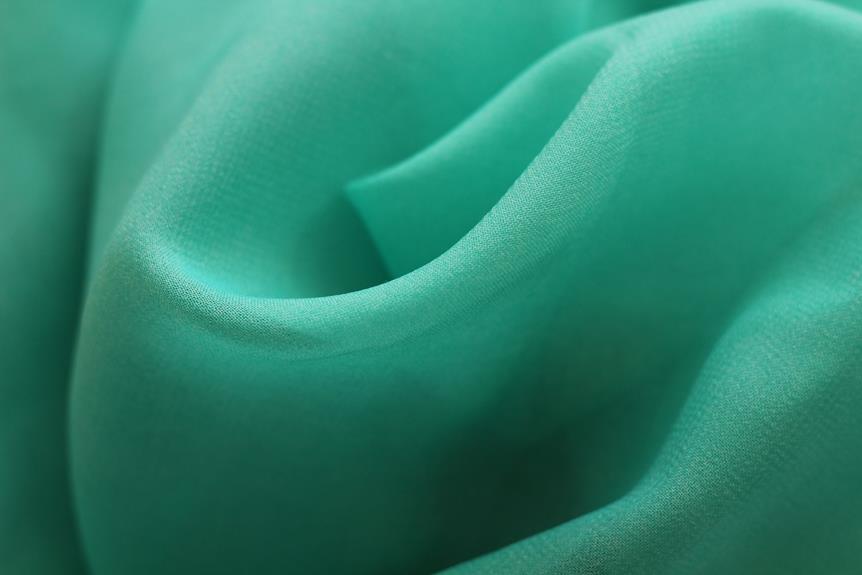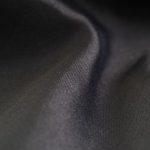If you've heard the saying 'an ounce of prevention is worth a pound of cure,' you may be wondering if you can Scotchgard polyester fabric. The answer is yes! Scotchgard can be applied to polyester fabric to provide protection against stains and spills.
In this guide, you'll learn about the benefits of Scotchgard, the characteristics of polyester fabric, the compatibility of Scotchgard with polyester, and the application process. You'll also discover maintenance and cleaning tips, as well as the durability and longevity of Scotchgard on polyester.
For those seeking mastery in fabric care, understanding how to Scotchgard polyester fabric is a valuable skill to have.
Key Takeaways
- Scotchgard creates a thin, invisible layer that repels liquid and blocks stains from penetrating polyester fabric.
- Polyester fabric is naturally stain-resistant and holds dye well, making it easier to clean and maintain.
- Conduct a compatibility test on a small, inconspicuous area of the fabric before applying Scotchgard to the entire fabric.
- Alternative fabric protectants like NanoTech Coatings Fabric Protector, 303 Fabric Guard, Crypton Fabric Protector, and Rust-Oleum NeverWet provide effective stain resistance and maintain the durability and longevity of polyester items.
Understanding Scotchgard and Its Benefits
How exactly does Scotchgard protect and enhance polyester fabric?
Scotchgard works by creating a thin, invisible layer that repels liquid and blocks stains from penetrating the fabric. This protective barrier not only safeguards the polyester fabric from spills and stains but also makes it easier to clean.
One of the key benefits of using Scotchgard on polyester fabric is its compatibility with a wide range of materials, including upholstery, clothing, and household textiles.
The application process is relatively simple, involving spraying the product evenly onto the fabric and allowing it to dry completely.
Additionally, Scotchgard provides long-lasting protection, reducing the frequency of deep cleaning and prolonging the fabric's lifespan.
When it comes to cleaning tips, it's important to blot spills immediately to prevent them from setting into the fabric. Regular vacuuming or gentle brushing can also help maintain the fabric's appearance.
Polyester Fabric Characteristics
After understanding how Scotchgard protects and enhances polyester fabric, you may want to explore the characteristics of polyester fabric itself. Polyester is a popular synthetic fabric known for its durability, wrinkle resistance, and ease of care. Below is a table summarizing the key characteristics of polyester fabric:
| Characteristic | Description |
|---|---|
| Durability | Polyester fabric is exceptionally durable and holds its shape well. It is resistant to stretching and shrinking, making it ideal for clothing and upholstery. |
| Wrinkle Resistance | Polyester is naturally wrinkle-resistant, making it a great choice for clothing and home textiles that require minimal maintenance. |
| Easy Care | This fabric is easy to care for and typically machine washable. It dries quickly and requires little to no ironing, making it a convenient option for everyday use. |
| Stain Resistance | Polyester fabric has inherent stain resistance, making it easier to clean and maintain. It is less prone to stains compared to natural fabrics, adding to its practicality. |
| Colorfastness | Polyester fabric holds dye well, resulting in vibrant and long-lasting colors. It retains its color even after repeated washings, maintaining a fresh appearance. |
Polyester fabric's characteristics make it an excellent choice for various applications, especially when considering factors such as fabric protection and stain resistance.
Compatibility of Scotchgard With Polyester
To determine the compatibility of Scotchgard with polyester, conduct a small test on an inconspicuous area of the fabric. Compatibility concerns arise due to potential chemical reactions between Scotchgard and polyester. By conducting a test in an inconspicuous area, you can observe any adverse effects before applying Scotchgard to the entire fabric.
Begin by applying a small amount of Scotchgard to an area of the polyester fabric that isn't easily visible. Follow the instructions on the Scotchgard product carefully. Allow it to dry and observe the area for any signs of discoloration, texture changes, or other adverse reactions. If the test area shows no negative effects, it's likely safe to proceed with treating the entire fabric. However, if there are any concerns or unexpected outcomes, it's best to avoid applying Scotchgard to the polyester fabric to prevent potential damage.
Understanding the compatibility of Scotchgard with polyester is crucial to ensure the fabric's longevity and protection. Conducting a small test can help prevent any unwanted consequences and preserve the quality of the polyester fabric.
Application Process for Polyester Fabric
When Scotchgarding polyester fabric, carefully follow the application instructions to ensure effective protection without compromising the fabric's integrity. Proper application techniques are crucial for achieving the best results. Here are some product recommendations and application techniques to effectively Scotchgard polyester fabric:
| Product | Application Technique |
|---|---|
| Scotchgard | Spray evenly from 6 inches away in a sweeping motion until the fabric is damp. Allow to dry completely. Reapply for additional protection. |
| 303 Fabric Guard | Apply to clean, dry fabric outdoors. Spray evenly and thoroughly on the fabric surface. Allow to dry for 6-12 hours. |
| Kiwi Camp Dry | Clean the fabric, then spray evenly from 10-12 inches away. Let it dry for 24-48 hours. Repeat for heavy-duty protection. |
Maintenance and Cleaning Tips
Regular cleaning and maintenance are essential for preserving the effectiveness of Scotchgard-treated polyester fabric. Here are some tips to help you maintain and clean your fabric effectively:
- Vacuuming: Regularly vacuum the fabric to remove dust, dirt, and debris that can contribute to staining and wear.
- Blotting: In the event of a spill, promptly blot the area with a clean, absorbent cloth to prevent the stain from setting.
- Gentle Cleaning: Use mild soap and water to gently clean the fabric, avoiding harsh chemicals that can degrade the Scotchgard treatment.
- Stain Prevention: Consider additional stain prevention methods such as using fabric covers or positioning the fabric away from high-risk areas to minimize potential stains.
Durability and Longevity of Scotchgard on Polyester
You should expect Scotchgard-treated polyester fabric to maintain its protective qualities for at least 10-12 washes, depending on usage and cleaning frequency. The long-term effectiveness of Scotchgard on polyester is influenced by its chemical composition.
Scotchgard forms a durable water repellent (DWR) coating on the fabric, which helps to resist liquid spills and stains. However, this protective coating can gradually wear off over time due to regular wear and cleaning.
The chemical composition of Scotchgard includes fluorinated compounds that create a protective barrier on the polyester fabric. This barrier repels liquids and prevents them from being absorbed, thus reducing the risk of staining. However, with repeated use and washing, the DWR coating can diminish, leading to decreased water repellency and stain resistance.
To maximize the longevity of Scotchgard on polyester, it's essential to follow the manufacturer's cleaning and care instructions. Avoiding frequent and harsh cleaning methods can help preserve the protective coating for a longer duration. Additionally, reapplying Scotchgard after a certain number of washes can help maintain its effectiveness in repelling liquids and prolong the durability of the polyester fabric.
Potential Alternatives to Scotchgard for Polyester
Consider exploring alternative fabric protectants for polyester to maintain its longevity and durability. There are several potential alternatives to Scotchgard for polyester that can provide effective fabric protection and stain repellent properties. Here are a few options to consider:
- NanoTech Coatings Fabric Protector: This advanced fabric protection formula creates a powerful barrier against stains and liquids without altering the fabric's texture or breathability.
- 303 Fabric Guard: Known for its ability to repel both water and oil-based stains, this fabric protectant can be used on a variety of polyester materials to provide long-lasting protection.
- Crypton Fabric Protector: Utilizing a patented technology, this fabric protector not only resists stains but also inhibits the growth of odor-causing bacteria, making it an ideal choice for high-traffic polyester upholstery.
- Rust-Oleum NeverWet Fabric Water Repelling Treatment: This innovative fabric treatment forms a protective barrier that causes water to bead up and roll off the surface, keeping polyester fabrics dry and stain-free.
Exploring these alternatives can help you find the right fabric protection solution for your polyester items, ensuring they remain durable and stain-resistant for years to come.
Frequently Asked Questions
Are There Any Specific Types of Polyester Fabric That Scotchgard Should Not Be Applied To?
When scotchgarding polyester fabric, it's important to consider specific polyester types and application precautions. Always check the fabric's care label and perform a spot test to ensure compatibility before treating it with scotchgard.
Can Scotchgard Be Used on Outdoor Polyester Fabric, Such as Patio Furniture or Awnings?
Yes, you can Scotchgard outdoor polyester fabric, such as patio furniture or awnings, to enhance outdoor durability and fabric protection. Follow the application process using recommended products for best results.
Is Scotchgard Safe to Use on Polyester Fabric That Will Be in Contact With Food or Beverages?
Yes, Scotchgard is generally safe for use on polyester fabric that will be in contact with food or beverages. However, be aware of application limitations and consider reapplication, especially if the fabric has existing coatings.
How Long Does Scotchgard Typically Last on Polyester Fabric Before Needing to Be Reapplied?
Scotchgard typically lasts on polyester fabric for about 6 months before needing reapplication. The effectiveness duration may vary based on usage and washing frequency. The application process involves spraying evenly and allowing it to dry completely.
Can Scotchgard Be Used on Polyester Fabric That Has Already Been Treated With a Stain-Resistant Coating?
Yes, you can Scotchgard polyester fabric even if it already has a stain-resistant coating. This helps maintain the fabric protection and extends the lifespan of the stain-resistant treatments, ensuring effective polyester care and stain resistant maintenance.
- How Does Ring Spun Cotton Affect Garment Fit and Shape Retention? - August 13, 2024
- What Are the Challenges in Producing Ring Spun Cotton? - August 13, 2024
- Is Ring Spun Cotton Suitable for Plus-Size Clothing? - August 13, 2024







